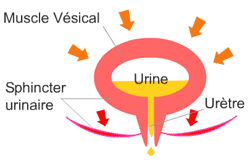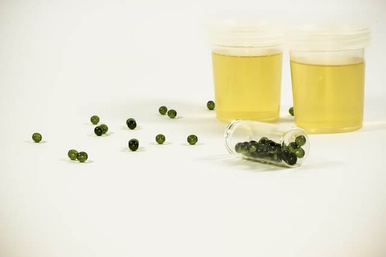Like all the organs of our body, the bladder also undergoes a phenomenon of aging
Urinary incontinence (uncontrollable need to urinate occurring very frequently) is unfortunately still the subject of a huge taboo, no doubt for this reason many people are reluctant to talk about it. Urinary incontinence is a real handicap that limits physical activities, disrupts social, sexual and professional life, and increases the risk of depression and anxiety related to embarrassment.

The problem is however widespread since it is considered that there are 2.5 million incontinents in France. Urinary incontinence primarily affects women after age 50. Risk factors include pregnancy and aging (menopause). In France, incontinence affects 25% of women over the age of 50 and 15% of men aged 60 and over. In men, at these ages, the problem is often related to prostate enlargement.
In addition, 10% of children aged 6 years or older suffer from a type of bedwetting called enuresis (bedwetting).
Causes of urinary incontinence
The causes of incontinence can vary from person to person.
- Some people suffer from an overactive bladder. It is an involuntary contraction of the bladder muscle (the detrusor), which causes a sudden and sometimes irrepressible urge to urinate, even if the bladder is not full. In addition, there is an increase in urinary frequency with a need to urinate more than 8 times in 24 hours, including at least 2 times during the night.
- True urinary incontinence consists of an involuntary loss of urine occurring while coughing, walking, laughing, or carrying heavy loads (stress incontinence).
- There is a third type of incontinence. In this case, this phenomenon occurs outside of exertion, including at night. It is often accompanied by urgent needs that, when not met in time, turn into leakage. The person often does not have time to reach the toilet (urge incontinence).
Dietary tips to avoid urinary incontinence
- If you are prone to incontinence, it is good for you to know that alcohol, tea and coffee often aggravate this urinary tract abnormality.
- It has been noted that people with bedwetting are particularly sensitive to food coloring, which tends to increase the problem.
- Foods containing oxalates such as spinach, strawberries and rhubarb can cause increased urination frequency and bedwetting, so avoid eating these foods late in the day or eat them with calcium-rich foods (calcium prevents oxalates from being absorbed into the bloodstream).
- Chewing a cinnamon stick at bedtime can be helpful.
Natural treatment with colloidal silica.
Fortunately, as with many other health problems, there are natural substances that can treat bladder diseases like urinary incontinence or overactive bladder.
Thus, the Americans have developed a patented mixture of plants (Aronia melanocarpa - Equisetum arvense) and minerals (magnesium and colloidal silica). This very special silica extraction process has been patented. It consists of converting the silica present in horsetail, which is very poorly assimilated by humans, into colloidal silica which is assimilable and very effective.
This nutritional supplement has already been the subject of 2 clinical studies in Australia and the United States. They have widely demonstrated both its efficacy and safety of use. In these studies, patients reduced their daytime urinary frequency by 25% after 1 month of treatment, 40% after 2 months and 50% after 3 months. As for the need to urinate during the night, it decreased by 28% after 1 month, by 62% after 2 months and by 70% after 3 months of treatment. Most of the patients included in these studies were able to go a full night without waking up to urinate after 2 months of treatment, whereas initially they had been waking up 2 to 3 times a night.
In conclusion, these 2 studies demonstrated that the product effective in reducing the discomfort of aging of the bladder in both men and women. It is worth noting that the maximum effect is only obtained after two to three months of treatment and that none of the participants showed any side effects.
Another laboratory study showed that the product has an enormous antioxidant activity (18 times more than blueberries and 30 times more than spinach!). It is this property that could explain its positive effect on the memory of the elderly. Our experience also reveals this product as an excellent remineralizer.
